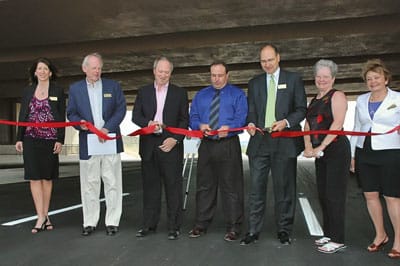RidgeGate Parkway Interchange Grand Opening

The new RidgeGate Parkway Interchange is at RidgeGate Parkway and I-25, approximately one mile south of Lincoln Avenue. It provides direct access to the Sky Ridge Medical Center and the RidgeGate development.
The Interchange design is similar to the nearby Lincoln Interchange with a partial cloverleaf of two loop ramps and was built for the 6-lane RidgeGate Parkway and 8-lane I-25.
A 12 foot path and an 8 foot sidewalk were constructed along RidgeGate Parkway at the Interchange, both elevated above the street.
Ames Construction was the construction contractor and PBS&J was the design engineer and construction manager.
The contract for the project was awarded in August 2007, with construction commencing in September 2007. The total cost of the project was $20.5 million.
It was a public/private project providing a solution to leverage CDOT’s resources to complete an improvement with regional benefits. Rampart Range Metropolitan District funded $13.5 million and CDOT funded $7 million. Other participants in the project included Coventry Development Corporation (right-of-way contribution), Douglas County (right-of-way contribution) and Sky Ridge Medical Center (provided easements). The City of Lone Tree owns the Interchange and is responsible for maintenance.
In addition to future widening work on I-25, there will be a new frontage road constructed between the RidgeGate Interchange and the Castle Pines Parkway Interchange. Direct access to Surrey Ridge Road and Schweiger Ranch from I-25 has been eliminated and access will be provided by the new frontage road.
The Interchange lays the foundation for the FasTracks’ end-of-line station for the Southeast Light Rail line. The extension of the southeast corridor light rail line into RidgeGate with three stations has been included in the RTD FasTracks Vision Plan.
Reduces traffic congestion and provides for regional connections (Lincoln Avenue, E-470, Parker Road, Castle Pines Parkway).
The Interchange will help to alleviate the traffic congestion on Lincoln Avenue just north on I-25. Traffic counts for Lincoln Avenue are:
East of I-25, 61,500 vehicles travel each day.
West of I-25, 37,500 vehicles travel each day.
I-25 carries 92,700 vehicles south of Lincoln and 106,800 vehicles north of Lincoln.
2,560 vehicles exit the SB I-25 off-ramp during the p.m. peak hours.
1,790 vehicles enter the NB I-25 on-ramp in the p.m. peak hours.
In 2006, CDOT initiated an archaeological excavation to gather and preserve materials related to prehistoric Native American existence in the area, in preparation for the RidgeGate Interchange construction.
I-25/Ridgegate Interchange Archaeological Excavation Background Information
CDOT archaeologists first identified the RidgeGate site in late 1993. The site was discovered during a survey along I-25 prior to the construction of a southbound acceleration lane, and was revisited on several occasions through the 1990’s as additional interstate improvement projects were developed. The site was determined to possibly contain important buried archaeological materials related to prehistoric Native American occupation of the area as indicated by a scatter of chipped stone flakes and tools on the ground surface in proximity to a series of rock clusters east of the highway.
CDOT was able to avoid disruption of the site throughout the years until the RidgeGate Interchange project was developed in the early 2000’s.
In 2002, CDOT conducted small-scale excavations to determine the general nature and extent of the cultural deposits as the site was located at the approximate center point of the interchange.
A variety of stone artifacts were recovered and several of the rock features were more fully exposed. Radiocarbon analysis performed on charcoal obtained from one of the features provided a date of 950 AD, indicating that the site was occupied over 1,000 years ago; a second date obtained from a deeper soil sample provided an age in excess of 8,000 years ago, suggesting that evidence of earlier occupations might also be present.
Archaeological excavations were initiated by a CDOT consultant in late April 2006 in order to preserve the site. The artifacts and evidence collected suggested that the site was a temporary, short-term hunting camp used repeatedly by bands of Native Americans for at least several thousand years.
The excavations were completed in July 2007 and the artifacts are now on display in Douglas County.